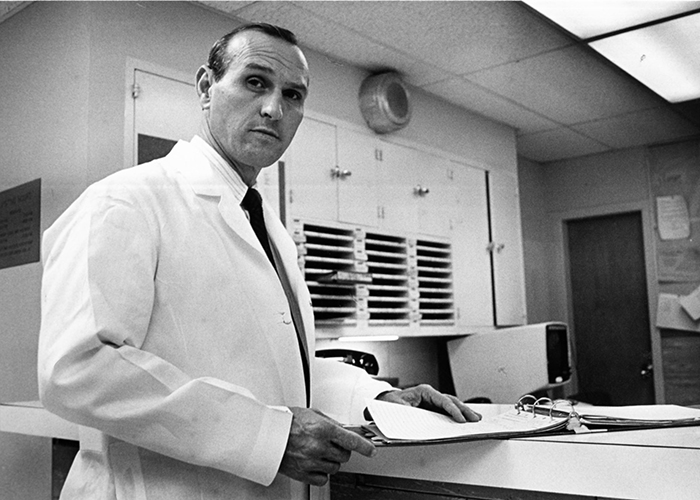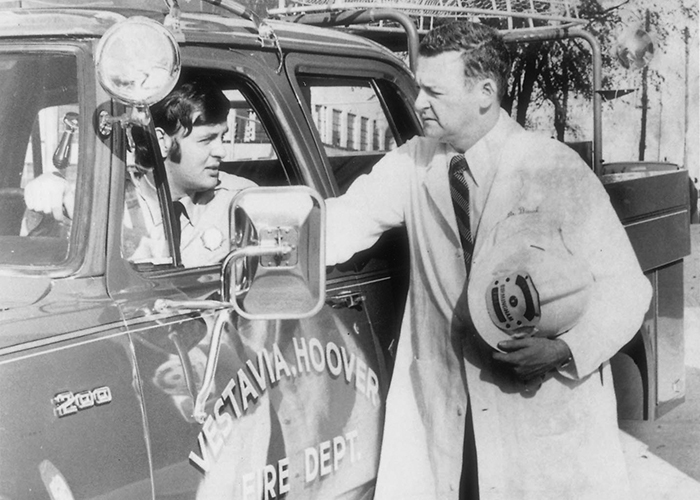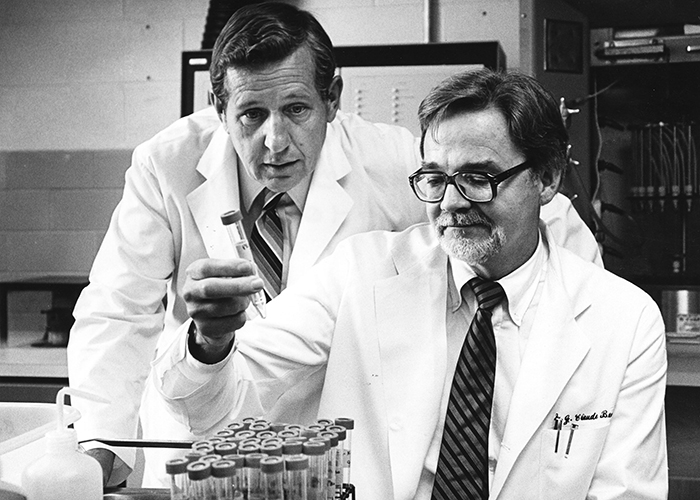 Over the winter, UAB and the School of Medicine lost three towering figures. This special section honors the careers and lasting impact of Arnold Diethelm, M.D., Alan Dimick, M.D., and Charles “Scotty” McCallum Jr., DMD, M.D.
Over the winter, UAB and the School of Medicine lost three towering figures. This special section honors the careers and lasting impact of Arnold Diethelm, M.D., Alan Dimick, M.D., and Charles “Scotty” McCallum Jr., DMD, M.D.
A Transplant Pioneer
Arnold Diethelm, M.D., former chair of the Department of Surgery and a leader in transplantation surgery at UAB, died January 28. A native of Baltimore, Maryland, Diethelm’s career at UAB began in 1967 when he joined the Department of Surgery, upon the completion of his two-year fellowship at Harvard and at the express invitation of John Kirklin, M.D., then-chair of the Department of Surgery.
Diethelm went on to serve as chair of the Department of Surgery from 1982-1999, was the author or co-author of more than 210 publications in peer-reviewed journals, served as a member of 26 surgical societies, and was honored with numerous memberships, awards, visiting professorships, and appointments. Among the countless physicians whose lives and careers he influenced, he hired current School of Medicine Dean and Senior Vice President of Medicine Selwyn Vickers, M.D., FACS, as the first Black/African American surgeon to be on the full-time faculty of the School of Medicine.
 Arnold Diethelm, M.D., January 13, 1932-January 28, 2021
Arnold Diethelm, M.D., January 13, 1932-January 28, 2021
“Dr. Diethelm set the standard of excellence in research, education, and patient care for the Department of Surgery and for transplant across the nation,” says Herbert Chen, M.D., the Fay Fletcher Kerner Chair of Surgery. “He announced to the world that our department would be a leader in the field of transplantation, and our incredible faculty, staff, and trainees continue to carry out his legacy every day.”
Diethelm also served as the 18th president of the American Society of Transplant Surgeons (ASTS). In an interview with the ASTS, Diethelm described some of his most memorable moments in transplantation as an attending physician. “Well, the first several transplants in Alabama were an interesting experience. Nobody had ever done a transplant in Alabama; they had no interest in it. And a new surgeon, a chairman of the department, Dr. John Kirklin, had just come. And Dr. Kirklin wanted to make transplantation an important part of his beginning department and he and the president of the university provided the support, and this became an institutional program. So, it was really the efforts of Dr. Kirklin and the president of the university, Dr. Joseph Volker, that allowed the program to succeed.”
Around 1999, Diethelm suffered from end-stage liver disease and underwent a successful liver transplant operation. “I went through all of that very well and I am a very lucky person. I realize that it is more luck to get the organ; it takes skill to make it work. And it takes a lot of work by a lot of people, the surgeons, the nurses, all of the other physicians that played a role.”
Under Diethelm’s leadership, UAB’s renal transplant program grew to become one of the largest and most respected in the country. He also helped to develop the Alabama Organ and Tissue Procurement Centers, and in 1994 was bestowed UAB’s highest honor, Distinguished Faculty Lecturer.
A Passion for Trauma Care
Alan Dimick, M.D., pioneering surgeon, burn specialist, and hospital integrationist, died at home on January 27 at the age of 88. Dimick’s wide range of accomplishments includes integrating University Hospital’s emergency rooms, establishing the UAB Burn Unit, and pushing for the creation of a modern paramedic service in Alabama.
“He was a recognized thought leader and participated nationally on panels that lead to the standardization of emergency rooms and prehospital emergency care,” says Jeffrey Kerby, M.D., Ph.D., director of the Division of Trauma and Acute Care Surgery. “His passion for organization of ambulance services in and around the Birmingham area, along with establishment of proper training programs for ambulance service providers, saved countless lives of Alabamians throughout the years and should be celebrated as part of his enduring legacy.” Alan Dimick, M.D., September 30, 1932-January 27, 2021
Alan Dimick, M.D., September 30, 1932-January 27, 2021
Dimick completed his surgical training in 1963 and went to work under Champ Lyons, M.D., then chair of the Department of Surgery at UAB. It was the height of the civil rights movement, and Lyons tasked Dimick with a seemingly tall order. “He said, ‘I’m going to give you two jobs,’” Dimick recalled in a 2018 UAB Medicine magazine profile. “‘The first is to start a burn center. The second is, I want you to combine the black and white emergency departments.’”
At that time University Hospital was still segregated. African American patients were treated in the old Hillman Emergency Room, known colloquially as ‘the hole’. White patients were treated at the other end of the hospital. “It was bad medicine,” Dimick said. “We had to change people’s thinking, but we gradually worked through all that.”
Dimick never forgot the day he was called to respond to the Sixteenth Street Baptist Church bombing on September 15, 1963. “I was cutting the grass at home when the hospital called and said there had been a bombing at a church. I drove in and it was a horrific thing, as you can imagine,” he said.
Four African American girls were killed that day: Addie Mae Collins (14), Denise McNair (11), Carole Robertson (14), and Cynthia Wesley (14). Dimick was among the hospital personnel who had the somber task of informing the girls’ parents of their deaths.
Dimick also recalled that his father’s work in the iron and steel industry inspired his pursuit of a career in medicine and burn care. “At that time … they were just putting Vaseline or some sort of ointment on (wounds). The smell was horrible, and the burns frequently got infected. A lot of patients died.” Dimick established the UAB Burn Unit in 1970 and served as its director until 1997.
Through a federal grant for emergency medicine, Dimick also helped establish the first paramedics in Alabama. UAB started its own paramedic training program and Dimick served as its medical director from 1975-1995, one of the many ways he left an indelible mark on our state.
A Tireless Supporter
Charles “Scotty” McCallum Jr., DMD, M.D, died January 16 at the age of 95. As UAB’s third president, the former mayor of Vestavia Hills, and a pillar in the Birmingham community for 70 years, McCallum was beloved by many.
“Our university family and the Birmingham community have lost a fierce advocate and a wonderful friend,” said UAB President Ray Watts. “Scotty believed in the people of this university, their work and their mission to provide a quality education to all and to build a medical facility that could care for the people of our state and beyond. Without his visionary leadership and dedication, UAB would not be the world-class institution it is today. Nancy and I are eternally grateful for Scotty’s life and join the UAB Family in sending our deepest sympathies to the McCallum family.” November 1, 1925–January 16, 2021
November 1, 1925–January 16, 2021
Before he was UAB’s third president, McCallum made a name for himself in the medical world. He first came to the city of Birmingham as an oral surgery intern in 1951, before earning his medical degree in 1957 from the Birmingham medical school, known today as UAB.
McCallum was named dean of the School of Dentistry at age 37, and later served as chair of the Department of Oral Surgery. A highly accomplished oral and maxillofacial surgeon, McCallum operated on thousands of Alabamians, and was inducted into the Alabama Academy of Honor in 1975 and into the Alabama Healthcare Hall of Fame in 1999.
McCallum served as president of UAB from 1987-1993, during which time one of his most famous achievements was the formal establishment of the UAB football team. McCallum also helped recruit the late Gene Bartow from UCLA to become UAB’s first men’s basketball coach and the first athletic director. McCallum was an enthusiastic attendee of UAB’s games, and Bartow once wrote that he was “the best college president any athletic director could ever have.”
After retiring from UAB, McCallum ran for mayor of Vestavia Hills at the encouragement of a group of Vestavia Hills residents, and served two terms as mayor. The McCallum Basic Health Sciences Building was named in honor of his service to UAB in 1996. In 2006, the university installed a life-sized statue of McCallum at the UAB Mini Park.
“I’m lucky that I came to Birmingham back in 1951,” McCallum told the Vulcan Park and Museum. “When you’re making other people happy, I think that’s so important. We’re here because God put us here to make this a better world and a better place and to be kind to other human beings. It’s a beautiful, beautiful challenge.”
By Caleb Jones
Photos courtesy of UAB Archives